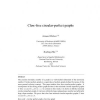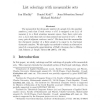134 search results - page 3 / 27 » A note on generalized chromatic number and generalized girth |
CEC
2003
IEEE
13 years 10 months ago
2003
IEEE
A population of virtual robots is evolved to perform the task of competitively painting the floor of a toroidal room. Two robots are present in any given room and paint using dis...
EJC
2006
13 years 5 months ago
2006
The general symplectic graph Sp(2, q) is introduced. It is shown that Sp(2, q) is strongly regular. Its parameters are computed, its chromatic number and group of graph automorphis...
ENDM
2007
13 years 5 months ago
2007
The circular chromatic number of a graph is a well-studied refinement of the chromatic number. Circular-perfect graphs is a superclass of perfect graphs defined by means of this...
DAM
2010
13 years 5 months ago
2010
In the minimum sum edge coloring problem, we aim to assign natural numbers to edges of a graph, so that adjacent edges receive different numbers, and the sum of the numbers assign...
JGT
2008
13 years 5 months ago
2008
The measurable list chromatic number of a graph G is the smallest number such that if each vertex v of G is assigned a set L(v) of measure in a fixed atomless measure space, the...


